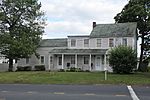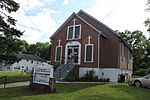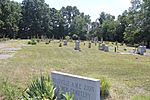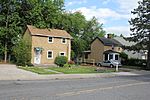Rossville, Staten Island facts for kids
Quick facts for kids
Rossville
|
|
|---|---|
|
Neighborhood of Staten Island
|
|
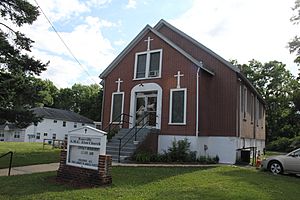
Rossville A.M.E. Zion Church
|
|
| Country | United States |
| State | New York |
| City | New York City |
| Borough | Staten Island |
| Established | 1684 |
Rossville is a neighborhood on the South Shore of Staten Island, New York City. It is located near the Arthur Kill waterway. Rossville is part of Staten Island Community Board 3.
Contents
History of Rossville
How Rossville Began
The area where Rossville is today was first home to the Raritan Indians. European settlers did not arrive much until 1684. That year, the British surveyed the land. They had gained Staten Island from the Dutch in 1667.
In 1692, Daniel Perrin, a Huguenot from Jersey, received 80 acres (320,000 m²) of land. This area was then called Smoking Point. The first known permanent settlement was around the early 1700s. It was started by Peter Winant, whose father was one of Staten Island's first settlers.
In the mid-1700s, the area was known as Old Blazing Star. Later, it was just Blazing Star. This name came from a local tavern. The Blazing Star Burial Ground, an old cemetery from the 1750s, is still there. It is located near Arthur Kill Road.
Rossville in the 1800s
The Blazing Star Ferry started operating before the American Revolution. It crossed the Arthur Kill to Woodbridge Township, New Jersey. In 1816, the Richmond Turnpike (now Victory Boulevard) was built. This road made it easier to travel to other parts of the island. It also connected to another ferry in Long Neck (now Travis).
By the 1830s, the area was named Rossville. This was after Colonel William E. Ross. He built a castle-like home overlooking the ferry landing. It looked like Windsor Castle and was first called Ross Castle.
In the mid-1800s, Rossville was a busy farming community. But when the Staten Island Railway opened in 1860, it did not go through Rossville. So, many people started calling Rossville part of Prince's Bay.
Transportation issues caused the town to decline. Things changed when the West Shore Expressway was finished in 1976. This led to a building boom. Farmers sold their land to developers. This caused fast growth in Rossville, which continues today.
Sandy Ground: A Historic Community
Inside Rossville is a special place called Sandy Ground. It is one of the oldest communities in the United States founded by free African Americans. This happened before the American Civil War. The first land purchase by an African American here was in 1828. This was just months after slavery ended in New York State.
Some of the old buildings in Sandy Ground are still standing. Five of them are even New York City landmarks. These include a church, a cemetery, and three homes. Some people living there today are descendants of the original settlers.
After slavery was abolished in New York in 1827, freedmen settled in Sandy Ground. This area was near Bloomingdale and Woodrow Roads. These early settlers were skilled in the oyster trade. They brought their knowledge to Staten Island. The main oyster harvesting area was Prince's Bay, close to Sandy Ground.
Sandy Ground was also an important stop on the Underground Railroad. It is the oldest continuously settled free black community in the United States. Oyster farming stopped around 1916 due to water pollution.
The 1963 Fire
On April 20, 1963, Rossville had a terrible brush fire. It was the worst of three fires on Staten Island that day. These fires destroyed over 100 homes. More than 500 people lost their homes. The damage was over $2 million.
Most of the original houses in Sandy Ground were destroyed in this fire. The fire changed Rossville forever. When the Verrazzano-Narrows Bridge opened 19 months later, many new homes were built. Many houses that survived the fire were torn down for new, larger ones.
Rossville Today
The Sandy Ground Historical Society was started in 1980. It works to save the history of the Sandy Ground community. It also runs the Sandy Ground Historical Museum.
Rossville was once mostly farmland. Now, it is mostly suburban. Many original residents have moved away. Developers bought their land and built new homes. However, as of 2008, ten families from the original settlers still lived in the area.
Important Places in Rossville
Older Buildings
St. Joseph's Church and Cemetery
St. Joseph's Church is the oldest Roman Catholic church still standing on Staten Island. It is on Poplar Avenue. It was founded in 1848. A small chapel was finished in 1851. In 1855, St. Joseph's became an official parish. It is the third oldest parish on Staten Island.
St. Joseph's Cemetery is also very old. It dates back to the early 1850s. It is the second oldest Catholic cemetery on the island.
Rossville African Methodist Episcopal Zion Church
The Zion African Methodist Episcopal Church was formed in 1850. William H. Pitts was its first minister. The current church building is one of four African American churches on Staten Island built before the 1900s. It is also one of two churches linked to African Methodism that existed before the Civil War.
Recent studies of the nearby burial ground found over 500 burials. This is a large collection of 19th-century African American burials in New York City.
Harris Home
The Harris family was one of the important families in Sandy Ground. The home of Isaac Harris, built around 1906, is still standing. Isaac was the son of Silas Harris, one of the first settlers in Sandy Ground. The house was designed by architect Stanford White. He drew the plans as a gift for Harris's service. This house is one of only about 12 original old homes left in the community.
Many families whose ancestors founded the community still live there today.
Landmark Properties
Five properties in Rossville have been named New York City landmarks.
Newer Buildings and Areas
Witte Marine Scrapyard
The Witte Marine Scrapyard is one of the largest marine scrapyards on the East Coast. It is also known as the Staten Island boat graveyard. It is located at 2453 Arthur Kill Road. The scrapyard opened in 1964. It is known for its many old boats, ferries, and other vessels. Many of these boats are slowly decaying in the Arthur Kill.
Some important vessels can be found here. These include the New York City Fire Department fireboat Abram S. Hewitt. This boat helped rescue people from the 1904 General Slocum tragedy. Scenes from the 2010 movie Salt, starring Angelina Jolie, were filmed here.
Woodbrooke Estates and Fawn Ridge
Rossville has two large condominium developments. Woodbrooke Estates has 629 units with 2, 3, or 4 bedrooms. It was built between 1981 and 1987. Fawn Ridge is a bit smaller, with 521 units. It was built between 1987 and 1990. A 26,000 square foot (2,400 m²) shopping center opened in 1992.
Fire Safety in Rossville
Rossville is home to FDNY Engine Company 168. This was the city's first new fire company in over ten years. It started in June 2005. Engine 168 operates from a new firehouse built in 2004. It also has an FDNY EMS Battalion.
Education in Rossville
Rossville is part of the New York City Department of Education. It is in Community School District 31.
Elementary school students go to PS 56 Louis DeSario School. Middle school students attend either IS 75 Frank D. Paulo School or IS 34 Totten School. For children with special learning needs, there is PS/IS 25, also known as South Richmond High School.
The local Roman Catholic elementary school is St. Joseph - St. Thomas School. Nearby high schools include Tottenville High School and St. Joseph by the Sea High School.
Getting Around Rossville
Rossville has several bus routes. The S74/S84 local buses run on Bloomingdale Road and Rossville Avenue. The S55 runs on Bloomingdale Road. Express buses to Manhattan include the SIM25 on Rossville Avenue and the SIM26 on Bloomingdale Road.
Some parts of Rossville are close enough to walk to the Pleasant Plains station on the Staten Island Railway. New York State Route 440 also passes through Rossville.
Famous People from Rossville
- James A. Bradley (1830–1921) – A brush maker and politician from New Jersey. He founded Asbury Park and Bradley Beach.
- Jasper Francis Cropsey (1823–1900) – A landscape artist from the Hudson River School. He was born on his family's farm in Rossville.
- Caleb Lyon (1822–1875) – A New York politician who later became Governor of the Territory of Idaho.
- Daniel Rodriguez (born 1964) – An operatic tenor known as "The Singing Policeman." He used to work in the NYPD's Ceremonial Unit.




